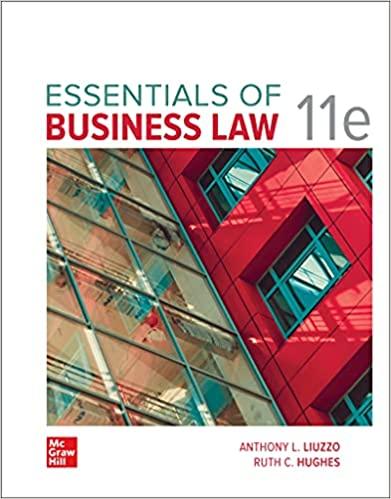Question
An arrested person can usually be released after putting up an amount of money known as bail. The purpose of bail is to assure the
"An arrested person can usually be
released after putting up an amount
of money known as bail. The purpose
of bail is to assure the court that the
defendant will return for trial. A con-
stitutional right to bail is recognized
in all but the most serious cases, such
as murder.
Bail may be paid directly to the
court. The entire amount may be
required, or in some places, the defen-
dant may be released after paying just
a portion of the total amount (for
example, 10 percent). If a person
released on bail fails to return, the
court will keep the money. If the
defendant does not have the money, a
bond company may put up a bail bond in exchange for a fee. For
example, a defendant with bail set at $2,000 might be released after
paying $200 to the bond company. If a bond is posted, the bond com-
pany will be required to pay the amount of the bond to the court if
the defendant does not report for trial.
The Eighth Amendment to the U.S. Constitution states that "exces-
sive bail shall not be required." However this does not specify how
much is excessive, and a poor person unable to raise any money could
be detained in jail before trial or conviction. Some people consider
this unfair, and some courts and legislatures have developed pro-
grams to release defendants without requiring any money.
To be eligible for release on personal recognizance, or personal
bond, the defendant must promise to return and must be con-
sidered a low risk of failing to show up for trial. In determining
the likelihood of the defendant's return, judges consider factors
such as the nature and circumstances of the offense and the
accused's family and community ties, financial resources,
employment background, and prior criminal record.
In addition to personal recognizance programs, courts may
set other nonmonetary conditions designed to ensure the
return of the defendant. These conditions include placing the
defendant in the custody of a third party or requiring the defen-
dant to maintain or get a job, to reside at a certain address, or to
report his or her whereabouts on a regular basis.
Despite the advantages of these programs, there can be problems in
releasing defendants, even though they have not yet been found guilty of
the crime with which they have been charged. Statistics indicate that
a large number of defendants commit crimes while out on bail.
To be eligible for pretrial
release, a defendant must be
considered a low risk of failing
to show up for trial. What
factors should a judge consider
when determining whether a
defendant will return for trial?
"Excessive bail
shall not be required,
nor excessive fines
imposed, nor cruel and
unusual punishments
inflicted."
Eighth Amendment to
the U.S. Constitution
155_165_CH13_879983.indd Page 157 8/8/08 11:27:20 PM elhi3 55_165_CH13_879983.indd Page 157 8/8/08 11:27:20 PM elhi3
PDF Proof
158 UNIT 2 Criminal Law and Juvenile Justice
As a result, some people argue that get-
ting out on bail should be more diffi-
cult. In 1984, Congress passed the Bail
Reform Act, which can prevent someone
from being freed on bail if he or she is
charged with a federal felony offense
and believed to be dangerous. For this
to occur, there must be a hearing, and
the person being denied bail must have
been charged with a violent crime or a
drug offense. In addition, the individual
must have been convicted of a felony
more than once. While the Supreme
Court has upheld the Bail Reform Act as
constitutional, most states have not
adopted similar legislation.
Supporters of pretrial release say that
it prevents punishment prior to convic-
tion and gives defendants the freedom
to help prepare their cases. Supporters
also claim that the U.S. justice system
rests on the presumption that defen-
dants are innocent until proven guilty
and that setting high bail or holding a
person in jail before trial goes against
that presumption."
- What is the purpose of the constitutional right to protection from excessive bail?
- How does the exclusionary rule work?
- Why do you think the Supreme Court adopted the exclusionary rule?
- What is the good faith exception to the exclusionary rule?
- What are some arguments in favor of the good faith exception? Against it?
Step by Step Solution
There are 3 Steps involved in it
Step: 1

Get Instant Access to Expert-Tailored Solutions
See step-by-step solutions with expert insights and AI powered tools for academic success
Step: 2

Step: 3

Ace Your Homework with AI
Get the answers you need in no time with our AI-driven, step-by-step assistance
Get Started


